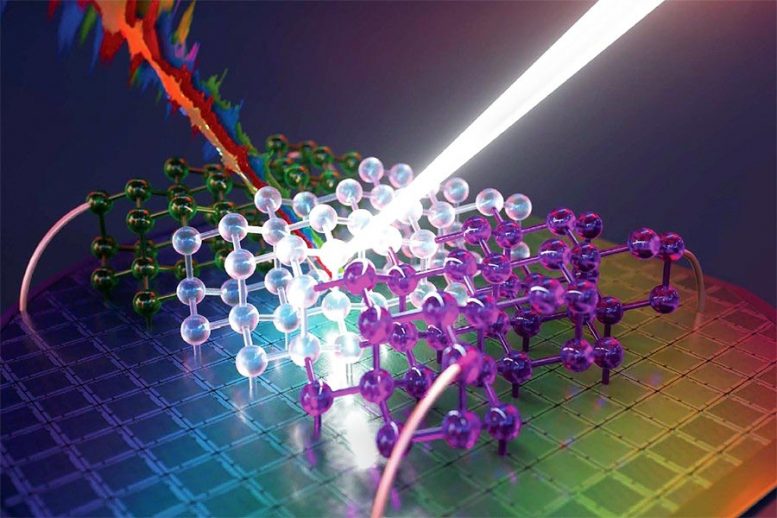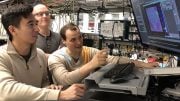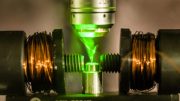
Prof. David Awschalom and 12 co-authors presented their analysis of quantum spintronics in the May 11, 2020 cover article of Applied Physics Letters. Credit: University of Chicago
Silicon carbide is in the race to become the leading material for developing an expanding system of quantum networks, according to an international team of scientists from the University of Chicago.
“What started out as a basic scientific enterprise by our group a number of years ago has developed into an exciting opportunity to engineer new quantum systems,” said David Awschalom, Liew Family Professor of Molecular Engineering at the Pritzker School of Molecular Engineering (PME), senior scientist at Argonne National Laboratory and director of the Chicago Quantum Exchange. “This particular system is already a successful commercial electronics technology; industry is well-prepared to manufacture devices.”
Awschalom and 12 co-authors presented their analysis of this technologically promising field—called quantum spintronics—in the May 11, 2020 cover article of Applied Physics Letters. Quantum spintronics uses the “spin” or magnetization of electrons and atomic nuclei to store and process information.
In their article, Awschalom and colleagues from UChicago, the University of Stuttgart, in Germany, and Linköping University, in Sweden, summarized the relative advantages that various quantum spintronics systems offer for developing new technologies. The paper coincides with an increasing industrial interest in using various types of quantum states to build prototype technologies for new types of sensing, communication, and computing.
Awschalom and co-authors focused their analysis on how semiconductors made of silicon carbide can serve as a highly flexible quantum technological platform. This material already is used for manufacturing power electronics, hybrid vehicles, and solid-state lighting. Surprisingly, Awschalom’s team describes how this everyday material can trap single electron spins to create the next generation of scalable quantum technologies.
“It’s exciting to think about working with foundries and commercial partners to move these technologies out of the lab and into the real world, using the same techniques that make your smartphone’s processor,” said UChicago postdoctoral scholar Chris Anderson, a co-author on the article.
“What started out as a basic scientific enterprise by our group a number of years ago has developed into an exciting opportunity to engineer new quantum systems.” — Prof. David Awschalom
An especially important advance in quantum information science highlighted in the article has been the ability to create and electrically control individual quantum states in commercial silicon carbide wafers that maintain quantum coherence, the length of time a quantum state can survive, for many milliseconds. Without quantum coherence, quantum computers and other technologies cannot operate. Many milliseconds, as brief as that may seem, ranks among the best quantum coherence times attained by any existing semiconductor. And Awschalom’s group is working on a technique that will greatly increase the quantum coherence time in silicon carbide materials. These increased coherence times are a direct result of the unique nature of the silicon carbide host, further indicating the promise of silicon carbide as an ideal material for quantum systems.
Awschalom and co-authors also describe that they can take a page from the modern electronics industry’s playbook to drastically improve their quantum states. “Electronic devices are all about shuffling electrons around in a controlled way,” said Anderson. “It turns out that we can use the same tricks to move electrons around to get rid of all of the unwanted electrical noise that our sensitive quantum system might see.”
Integrating qubits and photons for quantum communications
Another important advance in the application of silicon carbide to quantum communications is the integration of quantum bits with photons (individual particles of light), to transfer quantum information from matter to light, and then back to matter once again. Much like how the internet derives its usefulness and power from linking together many computers, an interface between matter and light is needed for sending quantum information over long distances, allowing quantum devices to communicate with each other to form vastly more powerful and complex systems.
“It’s exciting to think about working with foundries and commercial partners to move these technologies out of the lab and into the real world, using the same techniques that make your smartphone’s processor.” — Postdoctoral scholar Chris Anderson
“Not only do you want to create quantum bits that are robust and controllable in a semiconductor, but you’d like to be able to convert these into controllable photons,” Awschalom explained.
In this way, quantum information can be transformed from a single electron spin into a single photon for transmission over long distances. The spin-photon conversion process could also serve as quantum “wiring” for two quantum machines sitting a few meters to hundreds of miles apart.
This will be important for the construction of a long-range quantum network. Entangled quantum states could be used to send information between the network’s two endpoints. The exciting part is that this information can be perfectly secured; not by a man-made algorithm, but instead by the fundamental laws of physics.
“The excitement behind quantum networks stems not only from the possibly unfathomable amount of quantum computation power available distributed over many quantum devices, but also that the transferred information is provably secure without extensive cryptographic measures,” said Kevin Miao, a graduate student in Awschalom’s group at UChicago and another co-author on the article.
The signals holding that quantum information would begin to weaken over 100 miles if transmitted over optical fibers, greatly limiting future networks of quantum devices. Their range could be extended, however, by swapping the entangled state multiple times to build larger-scale networks. “This is exactly where we hope silicon carbide can make a big impact,” said Awschalom.
Awschalom’s group has additionally shown that silicon carbide has built-in quantum memories that consist of the quantum states of the atomic nuclei of the crystal. “If you have quantum memory, you can store the information and then move it back into the electron spin for processing,” Awschalom said. “Because these states are so fragile it’s important to have these long-lived memories”
Awschalom suspects that new applications may be coming soon. “It’s surprising how quickly things are moving from what began as fundamental science measurements in our labs in the last few years to some really interesting demonstrations and future technologies now. It shows how difficult it is to make predictions in this field.”
Reference: “Developing silicon carbide for quantum spintronics” by Nguyen T. Son, Christopher P. Anderson, Alexandre Bourassa, Kevin C. Miao, Charles Babin, Matthias Widmann, Matthias Niethammer, Jawad Ul Hassan, Naoya Morioka, Ivan G. Ivanov, Florian Kaiser, Joerg Wrachtrup and David D. Awschalom, 11 May 2020, Applied Physics Letters.
DOI: 10.1063/5.0004454







Be the first to comment on "New Analysis Shows Promise of Quantum Spintronics Based on Silicon Carbide"